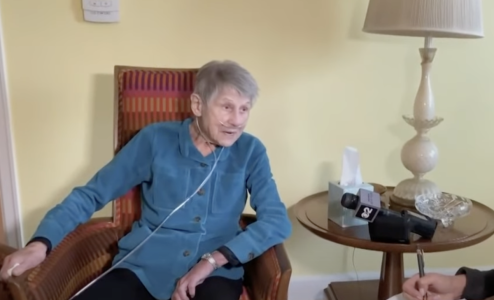Retirement dream derailed: How a senior housing promise left this 89-year-old with nearly nothing
By
Veronica E.
- Replies 0
You spend decades working hard and saving, hoping for a stable and peaceful retirement.
That was the plan for Arlene Kohen, an 89-year-old widow from Long Island.
She sold her home and invested nearly $1 million to join a senior community that promised lifelong care and partial refunds.
But after repeated bankruptcies, that promise crumbled—leaving her and her family facing major financial loss.
Her story is part of a growing crisis involving continuing-care retirement communities that are failing to deliver on their guarantees.

A million-dollar mistake
Arlene sold her longtime home for $838,000 and paid nearly $945,000 to join Harborside, a luxury senior community in Port Washington, New York.
The contract promised she or her heirs would get 75% of that money back if she moved or passed away.
It felt like a smart decision—until Harborside went bankrupt. Again.
After three bankruptcy filings (in 2014, 2021, and 2023), her family expects to recover less than a third of the $710,000 refund they were promised.
“That’s money that I’ll never see,” Arlene’s daughter said.
And unfortunately, Arlene’s story is far from unique.
Also read: The simple mistake that wiped out a man’s entire retirement savings
Widespread losses—and broken trust
Harborside’s failure is just one example of a larger crisis.
At least 16 CCRCs have filed for bankruptcy since 2020, affecting more than 1,000 seniors and wiping out over $190 million in entrance fees.
Some facilities shut down entirely. Others evicted residents or left them without promised care.
In Michigan, $112 million in refund claims at Henry Ford Village were never paid.
In Florida, over 100 seniors were removed from their homes when Unisen Senior Living shut down.
Colorado’s Casey’s Pond narrowly avoided closure after raising $30 million—while still owing $68.4 million to creditors.
Also read: Could your retirement be delayed? Find out if sweeping new age changes will impact you and 257 million Americans
How do these senior communities work—and why are they failing?
CCRCs are marketed as all-in-one solutions: independent living, assisted care, and memory support, all under one roof.
But that convenience comes at a steep cost—residents often pay hundreds of thousands upfront, plus monthly fees.
Many contracts promise partial refunds. But these businesses depend heavily on new residents’ entrance fees to cover their ongoing costs.
When home sales slow down or the economy dips, the pipeline of new funds dries up.
The system buckles, and residents—most of whom are considered “unsecured creditors”—are left with little recourse.
That’s exactly what happened at Harborside. Opened in 2010 after the housing crash, it struggled financially for years.
Despite attempts to restructure, the community couldn’t stay afloat.
A 2022 sale sealed its fate—leaving residents like Arlene with broken promises and little hope for repayment.
Also read: Thinking of working in retirement? Here’s where seniors are thriving
Beyond dollars: The human cost
The emotional toll of these failures is often just as severe as the financial losses.
Bob Curtis, another Harborside resident, paid $840,000 expecting a 50% refund.
His wife had to be transferred to another facility shortly before she passed away. He’s still waiting for some of that money back.
For seniors already navigating health challenges and life changes, the stress of moving or losing support is deeply unsettling.
These communities were supposed to be safe places to grow old.
Instead, they’ve become sources of grief, stress, and financial insecurity.
Also read: Are you making these 4 costly annuity mistakes? What retirement experts want every senior to know
Who’s protecting older Americans from this?
You might assume there are federal protections in place.
But in reality, oversight of CCRCs is limited and varies wildly by state.
The US Senate Special Committee on Aging raised concerns about CCRC vulnerabilities back in 2010—but little has changed.
Some states regulate CCRCs like insurance companies, but even that hasn’t prevented mass closures or unpaid refunds.
And industry lobbying often slows reform efforts. Many states simply don’t have the expertise or resources to monitor these complex financial operations.
Also read: Unlock hidden benefits! Discover the retirement perks your bank doesn’t advertise
How to protect yourself or a loved one
If you’re considering a move to a CCRC, take time to carefully evaluate the risks. Here are five key steps:
This could happen to anyone
As demand for senior housing grows, CCRCs will likely become even more popular.
But until consumer protections are strengthened, more families could face devastating losses.
At The GrayVine, we believe no one should lose their life savings trying to secure a peaceful retirement.
Let’s learn from these stories, stay informed, and support efforts to ensure every senior can age with dignity—and without fear.
Read next: Stop wasting cash: Seniors need to see these 7 retirement money pits immediately!

Have you or someone you know experienced financial trouble with a retirement facility? Or are you considering a move to a CCRC and have questions? Let us know in the comments. Your story could help others avoid the same fate.
That was the plan for Arlene Kohen, an 89-year-old widow from Long Island.
She sold her home and invested nearly $1 million to join a senior community that promised lifelong care and partial refunds.
But after repeated bankruptcies, that promise crumbled—leaving her and her family facing major financial loss.
Her story is part of a growing crisis involving continuing-care retirement communities that are failing to deliver on their guarantees.

Arlene Kohen, 89, hoped for a secure retirement—until her senior community's collapse left her family facing devastating financial loss. Image Source: YouTube /
CBS New York.
CBS New York.
A million-dollar mistake
Arlene sold her longtime home for $838,000 and paid nearly $945,000 to join Harborside, a luxury senior community in Port Washington, New York.
The contract promised she or her heirs would get 75% of that money back if she moved or passed away.
It felt like a smart decision—until Harborside went bankrupt. Again.
After three bankruptcy filings (in 2014, 2021, and 2023), her family expects to recover less than a third of the $710,000 refund they were promised.
“That’s money that I’ll never see,” Arlene’s daughter said.
And unfortunately, Arlene’s story is far from unique.
Also read: The simple mistake that wiped out a man’s entire retirement savings
Widespread losses—and broken trust
Harborside’s failure is just one example of a larger crisis.
At least 16 CCRCs have filed for bankruptcy since 2020, affecting more than 1,000 seniors and wiping out over $190 million in entrance fees.
Some facilities shut down entirely. Others evicted residents or left them without promised care.
In Michigan, $112 million in refund claims at Henry Ford Village were never paid.
In Florida, over 100 seniors were removed from their homes when Unisen Senior Living shut down.
Colorado’s Casey’s Pond narrowly avoided closure after raising $30 million—while still owing $68.4 million to creditors.
Also read: Could your retirement be delayed? Find out if sweeping new age changes will impact you and 257 million Americans
How do these senior communities work—and why are they failing?
CCRCs are marketed as all-in-one solutions: independent living, assisted care, and memory support, all under one roof.
But that convenience comes at a steep cost—residents often pay hundreds of thousands upfront, plus monthly fees.
Many contracts promise partial refunds. But these businesses depend heavily on new residents’ entrance fees to cover their ongoing costs.
When home sales slow down or the economy dips, the pipeline of new funds dries up.
The system buckles, and residents—most of whom are considered “unsecured creditors”—are left with little recourse.
That’s exactly what happened at Harborside. Opened in 2010 after the housing crash, it struggled financially for years.
Despite attempts to restructure, the community couldn’t stay afloat.
A 2022 sale sealed its fate—leaving residents like Arlene with broken promises and little hope for repayment.
Also read: Thinking of working in retirement? Here’s where seniors are thriving
Beyond dollars: The human cost
The emotional toll of these failures is often just as severe as the financial losses.
Bob Curtis, another Harborside resident, paid $840,000 expecting a 50% refund.
His wife had to be transferred to another facility shortly before she passed away. He’s still waiting for some of that money back.
For seniors already navigating health challenges and life changes, the stress of moving or losing support is deeply unsettling.
These communities were supposed to be safe places to grow old.
Instead, they’ve become sources of grief, stress, and financial insecurity.
Also read: Are you making these 4 costly annuity mistakes? What retirement experts want every senior to know
Who’s protecting older Americans from this?
You might assume there are federal protections in place.
But in reality, oversight of CCRCs is limited and varies wildly by state.
The US Senate Special Committee on Aging raised concerns about CCRC vulnerabilities back in 2010—but little has changed.
Some states regulate CCRCs like insurance companies, but even that hasn’t prevented mass closures or unpaid refunds.
And industry lobbying often slows reform efforts. Many states simply don’t have the expertise or resources to monitor these complex financial operations.
Also read: Unlock hidden benefits! Discover the retirement perks your bank doesn’t advertise
How to protect yourself or a loved one
If you’re considering a move to a CCRC, take time to carefully evaluate the risks. Here are five key steps:
- Ask for detailed financials. Look at audited reports, occupancy rates, and reserve funds.
- Read contracts carefully, including refund terms and bankruptcy clauses. Know your rights if the facility fails.
- Speak with a financial planner or elder law attorney before signing anything.
- Avoid putting all your assets into a single facility. Keep a financial safety net.
- Support policy reform and connect with advocacy groups pushing for stronger CCRC protections.
This could happen to anyone
As demand for senior housing grows, CCRCs will likely become even more popular.
But until consumer protections are strengthened, more families could face devastating losses.
At The GrayVine, we believe no one should lose their life savings trying to secure a peaceful retirement.
Let’s learn from these stories, stay informed, and support efforts to ensure every senior can age with dignity—and without fear.
Read next: Stop wasting cash: Seniors need to see these 7 retirement money pits immediately!
Key Takeaways
- An 89-year-old widow lost most of her savings after paying nearly $1 million to a CCRC that went bankrupt multiple times, leaving her family with only a partial refund.
- At least 16 continuing-care retirement communities across the US have collapsed since 2020, erasing over $190 million in entrance fees from more than 1,000 seniors.
- The CCRC model relies on new residents’ entrance fees to stay afloat—making them financially unstable during economic downturns or housing market slumps.
- Experts warn that inconsistent regulations and lack of strong consumer protections leave many older adults at serious financial and emotional risk.
Have you or someone you know experienced financial trouble with a retirement facility? Or are you considering a move to a CCRC and have questions? Let us know in the comments. Your story could help others avoid the same fate.






